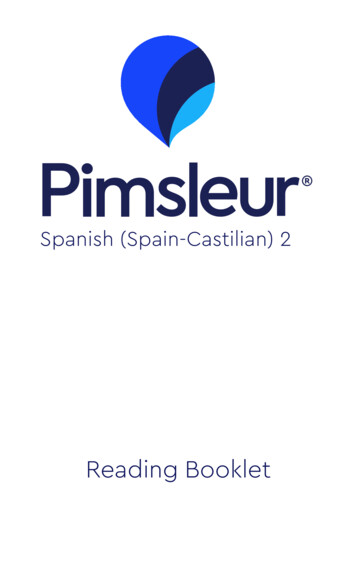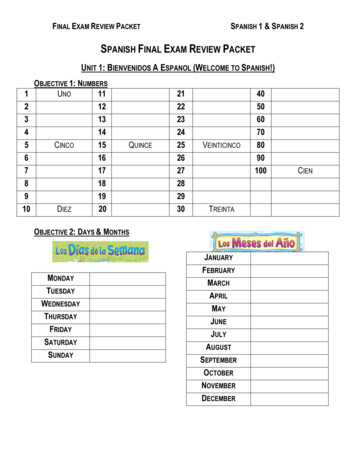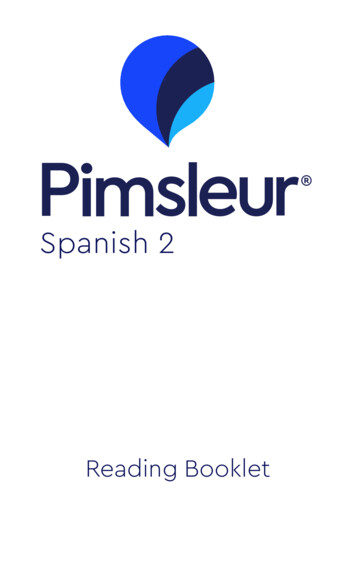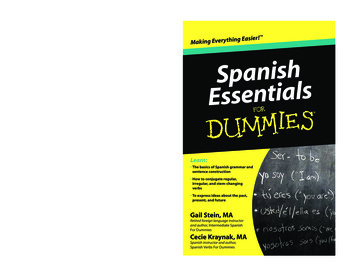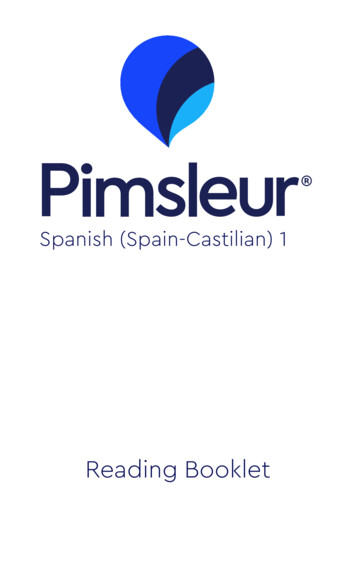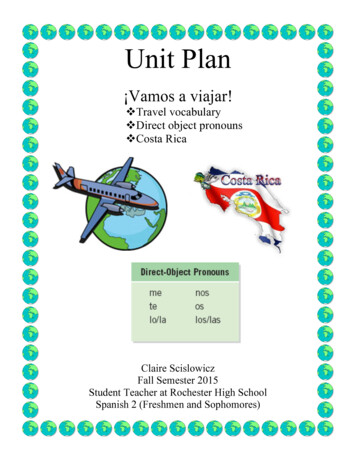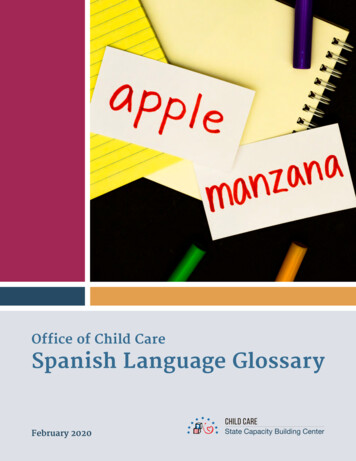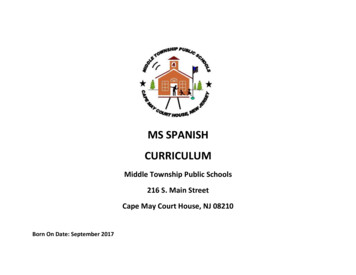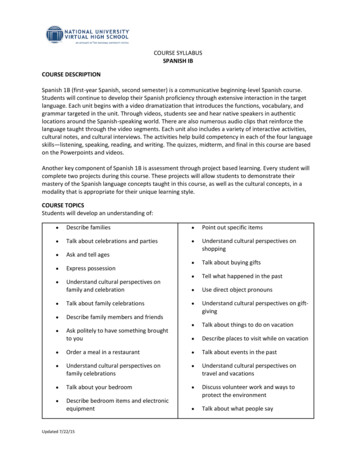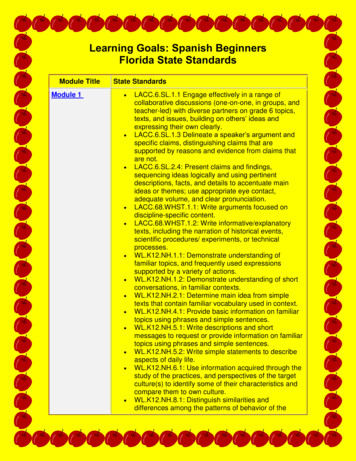
Transcription
Learning Goals: Spanish BeginnersFlorida State StandardsModule TitleModule 1State Standards LACC.6.SL.1.1 Engage effectively in a range ofcollaborative discussions (one-on-one, in groups, andteacher-led) with diverse partners on grade 6 topics,texts, and issues, building on others’ ideas andexpressing their own clearly.LACC.6.SL.1.3 Delineate a speaker’s argument andspecific claims, distinguishing claims that aresupported by reasons and evidence from claims thatare not.LACC.6.SL.2.4: Present claims and findings,sequencing ideas logically and using pertinentdescriptions, facts, and details to accentuate mainideas or themes; use appropriate eye contact,adequate volume, and clear pronunciation.LACC.68.WHST.1.1: Write arguments focused ondiscipline-specific content.LACC.68.WHST.1.2: Write informative/explanatorytexts, including the narration of historical events,scientific procedures/ experiments, or technicalprocesses.WL.K12.NH.1.1: Demonstrate understanding offamiliar topics, and frequently used expressionssupported by a variety of actions.WL.K12.NH.1.2: Demonstrate understanding of shortconversations, in familiar contexts.WL.K12.NH.2.1: Determine main idea from simpletexts that contain familiar vocabulary used in context.WL.K12.NH.4.1: Provide basic information on familiartopics using phrases and simple sentences.WL.K12.NH.5.1: Write descriptions and shortmessages to request or provide information on familiartopics using phrases and simple sentences.WL.K12.NH.5.2: Write simple statements to describeaspects of daily life.WL.K12.NH.6.1: Use information acquired through thestudy of the practices, and perspectives of the targetculture(s) to identify some of their characteristics andcompare them to own culture.WL.K12.NH.8.1: Distinguish similarities anddifferences among the patterns of behavior of the
target language by comparing information acquired inthe target language to further knowledge of ownlanguage and culture.WL.K12.NH.8.3: Compare and contrast specificcultural traits of the target culture and compare to ownculture (typical dances, food, celebrations, etc.)WL.K12.NM.1.1: Demonstrate understanding of basicwords, phrases, and questions about self and personalexperiences, through gestures, drawings, pictures, andactions.WL.K12.NM.1.2: Demonstrate understanding ofeveryday expressions dealing with simple andconcrete daily activities, and needs presented in aclear, slow, and repeated speech.WL.K12.NM.1.4: Demonstrate understanding of simpleinformation supported by visuals through a variety ofmedia.WL.K12.NM.1.6: Follow short, simple directions.WL.K12.NM.2.1: Demonstrate understanding of writtenfamiliar words, phrases, and simple sentencessupported by visuals.WL.K12.NM.2.3: Demonstrate understanding of simplewritten announcements with prompting and support.WL.K12.NM.2.4: Recognize words and phrases whenused in context on familiar topics.WL.K12.NM.3.1: Introduce self and others using basicculturally appropriate greetings.WL.K12.NM.3.2: Participate in basic conversationsusing words, phrases, and memorized expressions.WL.K12.NM.4.1: Provide basic information about selfand immediate surroundings using words and phrases,and memorized expressions.WL.K12.NM.4.2: Present personal information aboutself and others.WL.K12.NM.4.5: Role-play skits, songs, or poetry inthe target language that deal with familiar topics.WL.K12.NM.4.6: Present simple information about afamiliar topic using visuals.WL.K12.NM.5.1: Provide basic information in writingusing familiar topics, often using previously learnedexpressions and phrases.WL.K12.NM.5.3: Write simple sentences about selfand /or others.WL.K12.NM.5.4: Write simple sentences that help inday-to-day life communication.
Module 2 WL.K12.NM.5.5: Write about previously acquiredknowledge and experiences.WL.K12.NM.6.1: Recognize basic practices andperspectives of cultures where the target language isspoken (such as greetings, holiday celebrations, etc.)WL.K12.NM.6.2: Recognize common patterns ofbehavior (such as body language, gestures) andcultural practices and/or traditions associated with thetarget culture(s).WL.K12.NM.6.4: Recognize products of culture (e.g.,food, shelter, clothing, transportation, toys).WL.K12.NM.7.1: Identify keywords and phrases in thetarget language that are based on previous knowledgeacquired in subject area classes.WL.K12.NM.7.2: Identify (within a familiar context andsupported by visuals), basic information common tothe world language classroom and other disciplines.WL.K12.NM.8.2: Recognize true and false cognates inthe target language and compare them to ownlanguage.LACC.6.SL.1.1 Engage effectively in a range ofcollaborative discussions (one-on-one, in groups, andteacher-led) with diverse partners on grade 6 topics,texts, and issues, building on others’ ideas andexpressing their own clearly.LACC.6.SL.1.3 Delineate a speaker’s argument andspecific claims, distinguishing claims that aresupported by reasons and evidence from claims thatare not.LACC.6.SL.2.4: Present claims and findings,sequencing ideas logically and using pertinentdescriptions, facts, and details to accentuate mainideas or themes; use appropriate eye contact,adequate volume, and clear pronunciation.LACC.68.WHST.1.1: Write arguments focused ondiscipline-specific content.LACC.68.WHST.1.2: Write informative/explanatorytexts, including the narration of historical events,scientific procedures/ experiments, or technicalprocesses.WL.K12.NH.1.1: Demonstrate understanding offamiliar topics, and frequently used expressionssupported by a variety of actions.
WL.K12.NH.2.1: Determine main idea from simpletexts that contain familiar vocabulary used in context.WL.K12.NH.2.2: Identify the elements of story such assetting, theme and characters.WL.K12.NH.3.3: Exchange information using simplelanguage about personal preferences, needs, andfeelings.WL.K12.NH.4.1: Provide basic information on familiartopics using phrases and simple sentences.WL.K12.NH.4.2: Describe aspects of daily life usingcomplete sentences.WL.K12.NH.5.1: Write descriptions and shortmessages to request or provide information on familiartopics using phrases and simple sentences.WL.K12.NH.5.2: Write simple statements to describeaspects of daily life.WL.K12.NH.6.1: Use information acquired through thestudy of the practices, and perspectives of the targetculture(s) to identify some of their characteristics andcompare them to own culture.WL.K12.NH.6.2: Identify examples of common beliefsand attitudes and their relationship to practices in thecultures studied.WL.K12.NH.8.1: Distinguish similarities anddifferences among the patterns of behavior of thetarget language by comparing information acquired inthe target language to further knowledge of ownlanguage and culture.WL.K12.NH.8.2: Compare basic sound patterns andgrammatical structures between the target languageand own language.WL.K12.NH.8.3: Compare and contrast specificcultural traits of the target culture and compare to ownculture (typical dances, food, celebrations, etc.)WL.K12.NH.9.1: Use key target language vocabularyto communicate with others within and beyond theschool setting.WL.K12.NM.1.3: Demonstrate understanding of basicwords and phrases in simple messages andannouncements on familiar settings.WL.K12.NM.1.4: Demonstrate understanding of simpleinformation supported by visuals through a variety ofmedia.WL.K12.NM.2.1: Demonstrate understanding of writtenfamiliar words, phrases, and simple sentencessupported by visuals.
WL.K12.NM.2.2: Demonstrate understanding of short,simple literary stories.WL.K12.NM.2.3: Demonstrate understanding of simplewritten announcements with prompting and support.WL.K12.NM.2.4: Recognize words and phrases whenused in context on familiar topics.WL.K12.NM.3.3: Ask simple questions and providesimple responses related to personal preferences.WL.K12.NM.3.5: Understand and use in contextcommon concepts (such as numbers, days of theweek, etc.) in simple situations.WL.K12.NM.3.7: Understand and respondappropriately to simple directions.WL.K12.NM.4.1: Provide basic information about selfand immediate surroundings using words and phrases,and memorized expressions.WL.K12.NM.4.2: Present personal information aboutself and others.WL.K12.NM.4.3: Express likes and dislikes.WL.K12.NM.4.4: Provide an account of daily activities.WL.K12.NM.4.6: Present simple information about afamiliar topic using visuals.WL.K12.NM.5.1: Provide basic information in writingusing familiar topics, often using previously learnedexpressions and phrases.WL.K12.NM.5.3: Write simple sentences about selfand /or others.WL.K12.NM.5.4: Write simple sentences that help inday-to-day life communication.WL.K12.NM.5.5: Write about previously acquiredknowledge and experiences.WL.K12.NM.6.1: Recognize basic practices andperspectives of cultures where the target language isspoken (such as greetings, holiday celebrations, etc.)WL.K12.NM.6.2: Recognize common patterns ofbehavior (such as body language, gestures) andcultural practices and/or traditions associated with thetarget culture(s).WL.K12.NM.7.1: Identify keywords and phrases in thetarget language that are based on previous knowledgeacquired in subject area classes.WL.K12.NM.7.2: Identify (within a familiar context andsupported by visuals), basic information common tothe world language classroom and other disciplines.
Module 3 WL.K12.NM.8.1: Demonstrate basic knowledgeacquired in the target language in order to comparewords that are similar to those in his/her own languageWL.K12.NM.8.2: Recognize true and false cognates inthe target language and compare them to ownlanguage.WL.K12.NM.8.3: Identify celebrations typical of thetarget culture and one's own.LACC.6.SL.1.1 Engage effectively in a range ofcollaborative discussions (one-on-one, in groups, andteacher-led) with diverse partners on grade 6 topics,texts, and issues, building on others’ ideas andexpressing their own clearly.LACC.6.SL.1.3 Delineate a speaker’s argument andspecific claims, distinguishing claims that aresupported by reasons and evidence from claims thatare not.LAFS.68.RH.1.2 Determine the central ideas orinformation of a primary or secondary source; providean accurate summary of the source distinct from priorknowledge or opinions.LACC.6.SL.2.4: Present claims and findings,sequencing ideas logically and using pertinentdescriptions, facts, and details to accentuate mainideas or themes; use appropriate eye contact,adequate volume, and clear pronunciation.LACC.68.WHST.1.1: Write arguments focused ondiscipline-specific content.LACC.68.WHST.1.2: Write informative/explanatorytexts, including the narration of historical events,scientific procedures/ experiments, or technicalprocesses.WL.K12.NH.1.2: Demonstrate understanding of shortconversations, in familiar contexts.WL.K12.NH.2.1: Determine main idea from simpletexts that contain familiar vocabulary used in context.WL.K12.NH.2.2: Identify the elements of story such assetting, theme and characters.WL.K12.NH.3.1: Engage in short social interactionsusing phrases and simple sentences.WL.K12.NH.3.2: Exchange information about familiartasks, topics and activities, including personalinformation.
WL.K12.NH.3.4: Ask and answer a variety of questionsabout personal information.WL.K12.NH.4.2: Describe aspects of daily life usingcomplete sentences.WL.K12.NH.5.1: Write descriptions and shortmessages to request or provide information on familiartopics using phrases and simple sentences.WL.K12.NH.5.2: Write simple statements to describeaspects of daily life.WL.K12.NH.7.1 Use vocabulary acquired in the targetlanguage to access new knowledge from otherdisciplines.WL.K12.NH.8.3: Compare and contrast specificcultural traits of the target culture and compare to ownculture (typical dances, food, celebrations, etc.)WL.K12.NM.1.1: Demonstrate understanding of basicwords, phrases, and questions about self and personalexperiences, through gestures, drawings, pictures, andactions.WL.K12.NM.1.2: Demonstrate understanding ofeveryday expressions dealing with simple andconcrete daily activities, and needs presented in aclear, slow, and repeated speech.WL.K12.NM.1.3: Demonstrate understanding of basicwords and phrases in simple messages andannouncements on familiar settings.WL.K12.NM.1.4: Demonstrate understanding of simpleinformation supported by visuals through a variety ofmedia.WL.K12.NM.1.5: Demonstrate understanding of simplerhymes, songs, poems, and read aloud stories.WL.K12.NM.1.6: Follow short, simple directions.WL.K12.NM.2.1: Demonstrate understanding of writtenfamiliar words, phrases, and simple sentencessupported by visuals.WL.K12.NM.2.2: Demonstrate understanding of short,simple literary stories.WL.K12.NM.2.3: Demonstrate understanding of simplewritten announcements with prompting and support.WL.K12.NM.2.4: Recognize words and phrases whenused in context on familiar topics.WL.K12.NM.3.1: Introduce self and others using basicculturally appropriate greetings.WL.K12.NM.3.2: Participate in basic conversationsusing words, phrases, and memorized expressions.
WL.K12.NM.3.4: Exchange essential information aboutself, family, and familiar topics.WL.K12.NM.3.8: Differentiate among oral statements,questions, and exclamations in order to determinemeaning.WL.K12.NM.4.1: Provide basic information about selfand immediate surroundings using words and phrases,and memorized expressions.WL.K12.NM.4.2: Present personal information aboutself and others.WL.K12.NM.4.6: Present simple information about afamiliar topic using visuals.WL.K12.NM.5.1: Provide basic information in writingusing familiar topics, often using previously learnedexpressions and phrases.WL.K12.NM.5.2: Fill out a simple form with basicinformation.WL.K12.NM.5.3: Write simple sentences about selfand /or others.WL.K12.NM.5.4: Write simple sentences that help inday-to-day life communication.WL.K12.NM.5.5: Write about previously acquiredknowledge and experiences.WL.K12.NM.5.6: Pre-write by drawing pictures tosupport ideas related to a task.WL.K12.NM.5.7: Draw pictures in sequence todemonstrate a story plot.WL.K12.NM.6.1: Recognize basic practices andperspectives of cultures where the target language isspoken (such as greetings, holiday celebrations, etc.)WL.K12.NM.6.2: Recognize common patterns ofbehavior (such as body language, gestures) andcultural practices and/or traditions associated with thetarget culture(s).WL.K12.NM.6.4: Recognize products of culture (e.g.,food, shelter, clothing, transportation, toys).WL.K12.NM.7.2: Identify (within a familiar context andsupported by visuals), basic information common tothe world language classroom and other disciplines.
Module 4 LACC.6.SL.1.1 Engage effectively in a range ofcollaborative discussions (one-on-one, in groups, andteacher-led) with diverse partners on grade 6 topics,texts, and issues, building on others’ ideas andexpressing their own clearly.LACC.6.SL.1.3 Delineate a speaker’s argument andspecific claims, distinguishing claims that aresupported by reasons and evidence from claims thatare not.LACC.6.SL.2.4: Present claims and findings,sequencing ideas logically and using pertinentdescriptions, facts, and details to accentuate mainideas or themes; use appropriate eye contact,adequate volume, and clear pronunciation.LACC.68.WHST.1.1: Write arguments focused ondiscipline-specific content.LACC.68.WHST.1.2: Write informative/explanatorytexts, including the narration of historical events,scientific procedures/ experiments, or technicalprocesses.WL.K12.NM.4.4: Provide an account of daily activities.WL.K12.NH.2.1: Determine main idea from simpletexts that contain familiar vocabulary used in context.WL.K12.NH.2.2: Identify the elements of story such assetting, theme and characters.WL.K12.NH.3.2: Exchange information about familiartasks, topics and activities, including personalinformation.WL.K12.NH.4.2: Describe aspects of daily life usingcomplete sentences.WL.K12.NH.5.1: Write descriptions and shortmessages to request or provide information on familiartopics using phrases and simple sentences.WL.K12.NH.5.2: Write simple statements to describeaspects of daily life.WL.K12.NH.6.1: Use information acquired through thestudy of the practices, and perspectives of the targetculture(s) to identify some of their characteristics andcompare them to own culture.WL.K12.NH.6.2: Identify examples of common beliefsand attitudes and their relationship to practices in thecultures studied.WL.K12.NH.8.3: Compare and contrast specificcultural traits of the target culture and compare to ownculture (typical dances, food, celebrations, etc.)
WL.K12.NM.1.1: Demonstrate understanding of basicwords, phrases, and questions about self and personalexperiences, through gestures, drawings, pictures, andactions.WL.K12.NM.1.2: Demonstrate understanding ofeveryday expressions dealing with simple andconcrete daily activities, and needs presented in aclear, slow, and repeated speech.WL.K12.NM.1.4: Demonstrate understanding of simpleinformation supported by visuals through a variety ofmedia.WL.K12.NM.1.6: Follow short, simple directions.WL.K12.NM.2.2: Demonstrate understanding of short,simple literary stories.WL.K12.NM.2.3: Demonstrate understanding of simplewritten announcements with prompting and support.WL.K12.NM.2.4: Recognize words and phrases whenused in context on familiar topics.WL.K12.NM.3.6: Use appropriate gestures, bodylanguage, and intonation to clarify a message.WL.K12.NM.4.1: Provide basic information about selfand immediate surroundings using words and phrases,and memorized expressions.WL.K12.NM.4.2: Present personal information aboutself and others.WL.K12.NM.4.6: Present simple information about afamiliar topic using visuals.WL.K12.NM.5.1: Provide basic information in writingusing familiar topics, often using previously learnedexpressions and phrases.WL.K12.NM.5.3: Write simple sentences about selfand /or others.WL.K12.NM.5.4: Write simple sentences that help inday-to-day life communication.WL.K12.NM.5.5: Write about previously acquiredknowledge and experiences.WL.K12.NM.6.2: Recognize common patterns ofbehavior (such as body language, gestures) andcultural practices and/or traditions associated with thetarget culture(s).WL.K12.NM.6.3: Participate in age-appropriate andculturally authentic activities such as celebrations,songs, games, and dances.WL.K12.NM.6.4: Recognize products of culture (e.g.,food, shelter, clothing, transportation, toys).
WL.K12.NM.8.2: Recognize true and false cognates inthe target language and compare them to ownlanguage.WL.K12.NM.8.3: Identify celebrations typical of thetarget culture and one's own.WL.K12.NM.9.1: Use key words and phrases in thetarget language to participate in different activities inthe school and community settings.WL.K12.NM.9.2: Participate in simple presentations,activities, and cultural events in local, global, and/oronline communities.
Learning Goals: Spanish Beginners Florida State Standards Module Title State Standards Module 1 LACC.6.SL.1.1 Engage effectively in a range of collaborative discussions (one-on-one, in groups, and teacher-led) with diverse partners on grade 6 topics, texts, and issues, bu
